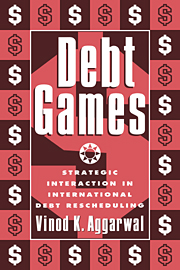Book contents
- Frontmatter
- Contents
- Preface
- Overview
- Part I Argument
- Part II Epoch I: 1820s–1860s
- 5 The intersection of high and low politics: Mexican debt rescheduling, 1824–1867
- 6 Guano makes the world go 'round: Peruvian debt rescheduling, 1823–1850s
- Part III Epoch 2: 1860s–1910s
- Part IV Epoch 3: 1910s–1950s
- Part V Epoch 4: 1970s–1990s
- Part VI Implications
- Appendix
- Bibliography
- Index
6 - Guano makes the world go 'round: Peruvian debt rescheduling, 1823–1850s
Published online by Cambridge University Press: 02 December 2009
- Frontmatter
- Contents
- Preface
- Overview
- Part I Argument
- Part II Epoch I: 1820s–1860s
- 5 The intersection of high and low politics: Mexican debt rescheduling, 1824–1867
- 6 Guano makes the world go 'round: Peruvian debt rescheduling, 1823–1850s
- Part III Epoch 2: 1860s–1910s
- Part IV Epoch 3: 1910s–1950s
- Part V Epoch 4: 1970s–1990s
- Part VI Implications
- Appendix
- Bibliography
- Index
Summary
Peru possessed greater mineral and agricultural resources than any other region of Spanish South America, and thus represented both a political and military center for the Spanish colonial empire. The colony's wealth, combined with the benefits enjoyed by the upper classes, delayed Peru's revolt against Spanish domination compared to the revolts of other Latin American countries.
In fact, Peru's initial impetus for revolution came from outside the Andean region. General José de San Martén, an Argentine who had successfully fought for the liberation of Chile, believed that maintaining the independence of the newly formed South American republics required complete Spanish expulsion from the continent. In the early 1820s he led his forces against the Spanish royalists in Peru and fleetingly gained the upper hand. But depleted finances and suspicions concerning his plans to establish a monarchy made San Martín unpopular with Peruvians. Even though San Martín withdrew from Peru by September 1822, his agents in London, Juan García del Río and James Paroissien, continued to busily negotiate a loan to fund Peru's fight against Spanish forces. By October the two ministers had arranged Peru's first loan of £1.2 million at a 6% interest rate, floated by the London firm of Thomas Kinder. The Peruvian Congress enthusiastically endorsed the full loan, but the government only received £700,000 because the investors were pessimistic about Peru's chances for independence. The final amount of the loan was also reduced because investors harbored suspicions that both ministers and Kinder had been involved in speculation related to the purchase of the Peruvian bonds.
- Type
- Chapter
- Information
- Debt GamesStrategic Interaction in International Debt Rescheduling, pp. 138 - 160Publisher: Cambridge University PressPrint publication year: 1996



